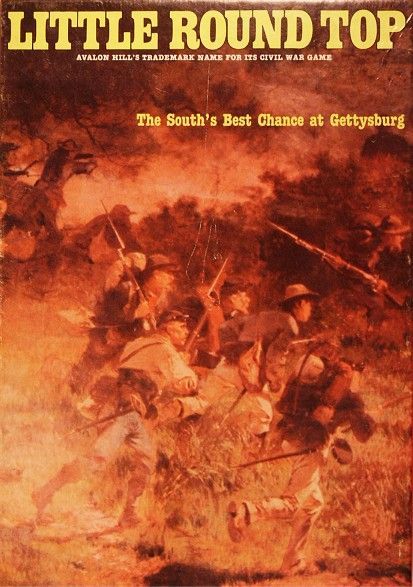Little Round Top: The South’s Best Chance at Gettysburg (1979) Board Game
Little Round Top: The South’s Best Chance at Gettysburg is a wargame that was released in in 1979. It is set during the American Civil War and focuses on the Battle of Gettysburg, specifically the fight for Little Round Top. The game is designed for 2 players and has a runtime of approximately 150 minutes. Players take on the roles of Confederate and Union commanders, strategizing and battling it out in an attempt to secure victory.
Game Components of Little Round Top: The South’s Best Chance at Gettysburg
Map: A colorful hex grid map representing the battlefield, scaled at 20 yards per hex.
Counters: 100 cardboard playing pieces that represent various units and leaders from both the Union and Confederate armies.
Rulebook: A short rules booklet, typically around 12 pages, detailing gameplay mechanics, unit capabilities, and combat resolution.
Player Aids: Additional aids may be included to help players track commands and actions during the game.
How To Setup Little Round Top: The South’s Best Chance at Gettysburg
- Game Components:
- Unfold the game board, which features a hex grid map scaled at 20 yards per hex.
- Gather the 100 cardboard counters representing Union and Confederate units.
- Map Orientation:
- Place the map on a flat surface where both players can easily access it.
- Ensure that all players are familiar with the terrain features depicted on the map, including hills, woods, and obstacles.
- Starting Positions:
- Union Forces:
- Position the Union units according to the scenario rules. Typically, they will be set up around Little Round Top and other strategic locations.
- Confederate Forces:
- Place Confederate units on the designated entry points as specified in the scenario rules.
- Union Forces:
- Command Points:
- Each player should determine their leaders and distribute command points as indicated in the rulebook.
- Ensure that players understand the command distance for each leader, as this affects unit actions.
- Victory Conditions:
- Review the victory conditions outlined in the rulebook so both players know how to achieve victory during gameplay.
- Additional Setup:
- Players may want to place any additional terrain markers or obstacles (like fences or walls) on the board as specified in the scenario rules.
- Game Turn Order:
- Decide which player will go first, typically determined by a dice roll or mutual agreement.
Gameplay Mechanics and Game Objective
- Τhe game accommodates two players, each commanding forces representing either the Union or Confederate armies.
- Objective: Players aim to maneuver their troops strategically across a map of the battlefield, engaging in rifle fire and bayonet charges to gain control over key positions.
- Turn Structure: Each turn involves moving company-sized units and positioning them for combat. Players must consider terrain advantages and the strengths of their units when deciding their strategies.
- Combat Resolution: The game employs a system that resolves conflicts based on unit positioning and strength, reflecting the chaotic nature of Civil War battles.
Player Experience
Pros:
- Immersive gameplay that captures the tension of the Battle of Gettysburg.
- Strategic depth with multiple paths to victory.
- Historical accuracy in terms of unit abilities and terrain effects.
Cons:
- Steep learning curve for new players.
- Lengthy runtime may not be suitable for casual gamers.
- Limited replayability due to fixed scenarios.
Personal Thoughts on Little Round Top: The South’s Best Chance at Gettysburg
Little Round Top: The South’s Best Chance at Gettysburg is a niche wargame that will appeal to fans of historical simulations and tactical combat. The game’s attention to detail in terms of historical accuracy and strategic depth is commendable, but it may not be the best choice for players looking for a quick and casual gaming experience. The pricing and availability of the game, especially for new copies, can vary, so it’s worth considering whether the investment is worth it for you. Overall, if you’re a history buff or a wargame enthusiast, this game is definitely worth your time. However, if you’re looking for a more accessible and fast-paced gaming experience, you may want to skip this one.
Game Components of The 20th Maine: The Battle for Little Round Top
How To Setup The 20th Maine: The Battle for Little Round Top
Setup involves placing units on the map according to historical deployment. The Union army, led by Col. Joshua Lawrence Chamberlain’s 20th Maine Infantry Regiment, must be positioned to defend Little Round Top. The Confederate forces, aiming to roll up the Union left flank, are set up accordingly. The game requires careful placement of units and leaders to reflect the historical context accurately.Gameplay Mechanics and Game Objective
Player Experience
Playing **The 20th Maine** is an immersive experience that requires strategic thinking and tactical execution. The game’s rule set, though complex with 12 pages of rules, is praised for its clarity and organization. Players must balance maneuver and attacks, use leaders effectively, and manage command points carefully. The decision to fix bayonets, for instance, adds a layer of strategy that can be crucial in melee combat.Pros
Cons
Personal Thoughts on The 20th Maine: The Battle for Little Round Top
This game is ideal for wargame enthusiasts and history buffs, particularly those interested in the American Civil War. It offers a challenging and historically accurate simulation of a pivotal battle, requiring careful strategic planning and tactical execution. For those who enjoy detailed and complex wargames, **The 20th Maine** is a remarkable bargain that provides hours of engaging gameplay. However, it may not be the best fit for casual gamers due to its complexity and depth.We are supported by our audience. When you purchase through links on our site, we may earn an affiliate commission, at no extra cost for you. Learn more.

